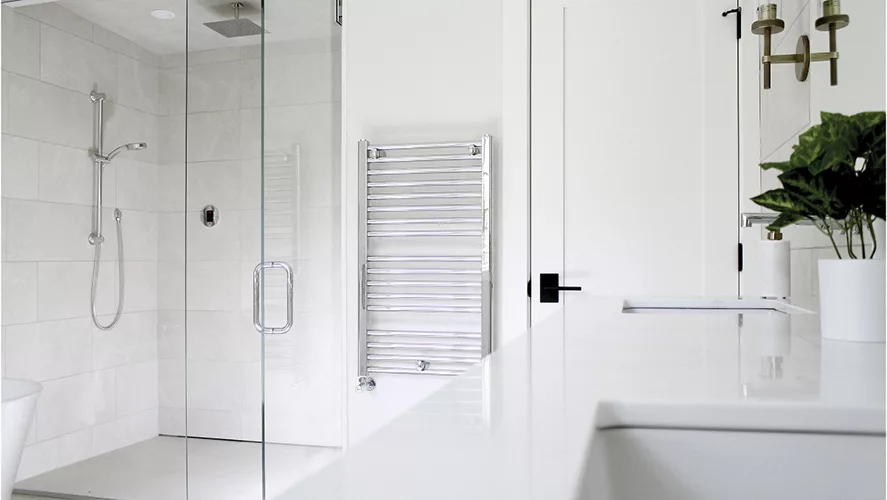In the hospitality industry, bathrooms are high-traffic zones that endure considerable wear and tear, making their construction a pivotal aspect in ensuring sustained functionality, safety and aesthetic appeal. Overlooking the importance of ongoing maintenance can result in expensive repairs, safety risks and diminished guest satisfaction.
By employing thoughtful design and selecting durable materials that guarantee easier maintenance, plumbing engineers can help ensure that hotel and commercial bathrooms stand the test of time, remaining both operational and visually pleasing.
Design for Longevity
When specifying and designing plumbing systems for commercial bathrooms, material durability plays a pivotal role, particularly in high-traffic areas prone to significant wear and tear. Opting for materials that can sustain heavy use not only enhances a bathroom’s longevity but also reduces costs over time by minimizing the need for regular maintenance and replacements.
Consider the following factors when selecting commercial bathroom materials:
1) Ensure the chosen materials exhibit high resistance to moisture — a characteristic essential for maintaining the integrity of the plumbing system against the rigors of daily use.
2) Assess the material’s suitability for the specific environmental conditions of the project location. For example, in areas with high humidity and frequent rainfall, opt for materials that are resilient to moisture-induced deterioration, such as cracking or chipping, over extended periods.
3) Consider the user experience. For both employees and guests who will utilize these facilities regularly, ease of maintenance is a significant factor. For example, smooth surfaces simplify cleaning, compared to those with textured or rough finishes that might harbor dirt and bacteria.
Easy Maintenance Upgrades
Incorporating fixtures that are easy to clean and maintain can significantly reduce maintenance costs by minimizing the time required to clean the space. They also provide sanitation advantages, such as a decreased risk of cross-contamination, enhanced overall cleanliness and reduced cleaning time.
For example, when selecting shower drainage, implementing linear drains reduces grout lines and seams, where mold, mildew and dirt accumulate.
Linear drains eliminate the conventional four-way slope found in traditional shower pans, allowing for a seamless transition from the broader bathroom area into the shower. This design facilitates the use of large format tiles and solid surface materials, ensuring complete water evacuation from shower spaces. This reduces the likelihood of water stagnation and leakage beneath the shower door into the surrounding bathroom area.

Oatey’s QuickDrain system is a linear drain solution that offers wall-to-wall coverage and a fully sloped trough, that helps mitigate slip hazards, drain water efficiently and reduce mold, mildew, and bacteria growth.
Converting bathtubs into walk-in showers is easier with solutions like Oatey’s QuickDrain system. The kit includes a site-adjustable linear drain body, a waterproofing system, on-site customizable pre-pitched polyethylene terephthalate (PET) foam shower panels, and drain covers that match the design. The customizable components are easy to install and decrease maintenance.
Selecting bathroom fixtures coated with physical vapor deposition (PVD) can enhance aesthetic appeal and durability. PVD coatings offer superior resistance to physical damages such as chipping, scratching or fading and perform better than conventional thick hard chrome layers in terms of abrasion resistance, which also makes them easier to clean.
For visible plumbing components, Dearborn’s Safety Series tubular p-trap covers have a universal design that covers brass and plastic tubular products. Fabricated from ethylene vinyl acetate (EVA) foam, these covers are easy to clean, boast antimicrobial properties and resist yellowing over time. This feature is particularly useful in ADA-compliant bathrooms.
Other Plumbing Considerations
Proper plumbing is critical for maintaining a commercial bathroom for years to come. Upgrading to water-saving fixtures, preventing leaks and water damage, and maintaining proper water pressure help keep a commercial bathroom easy to clean and maintain.
Upgrading to water-saving fixtures, such as low-flush-volume toilets and urinals, as well as low-flow faucets can reduce water usage while maintaining optimal performance. These fixtures are designed to use less water without compromising the bathroom’s functionality.

Leaks and water damage can cause significant harm to your customer’s bathroom and beyond, potentially extending to the entire building. Inspecting the plumbing system can help identify leaks and prevent water damage. Leaks around fixtures and fittings — faucets, sinks, toilets, urinals and pipes — should be fixed immediately to prevent further damage. It’s also important to ensure that pipes are well-insulated to prevent freezing and bursting during cold weather if the area’s temperatures drop well below 32 F.
Reduce downtime and inconvenience caused by plumbing repairs by specifying water stop valves, which are designed to shut off the water supply at the source of the individual fixtures. This makes it easy to perform maintenance and repairs without having to shut off the water to the entire building.
Evan Novak is a 15-year veteran of the plumbing industry, who has served as a senior manager of commercial sales at Oatey Co. since September 2018. A graduate of Ohio University, Novak holds a master’s degree in business administration from Clemson University. He can be reached at: [email protected].




